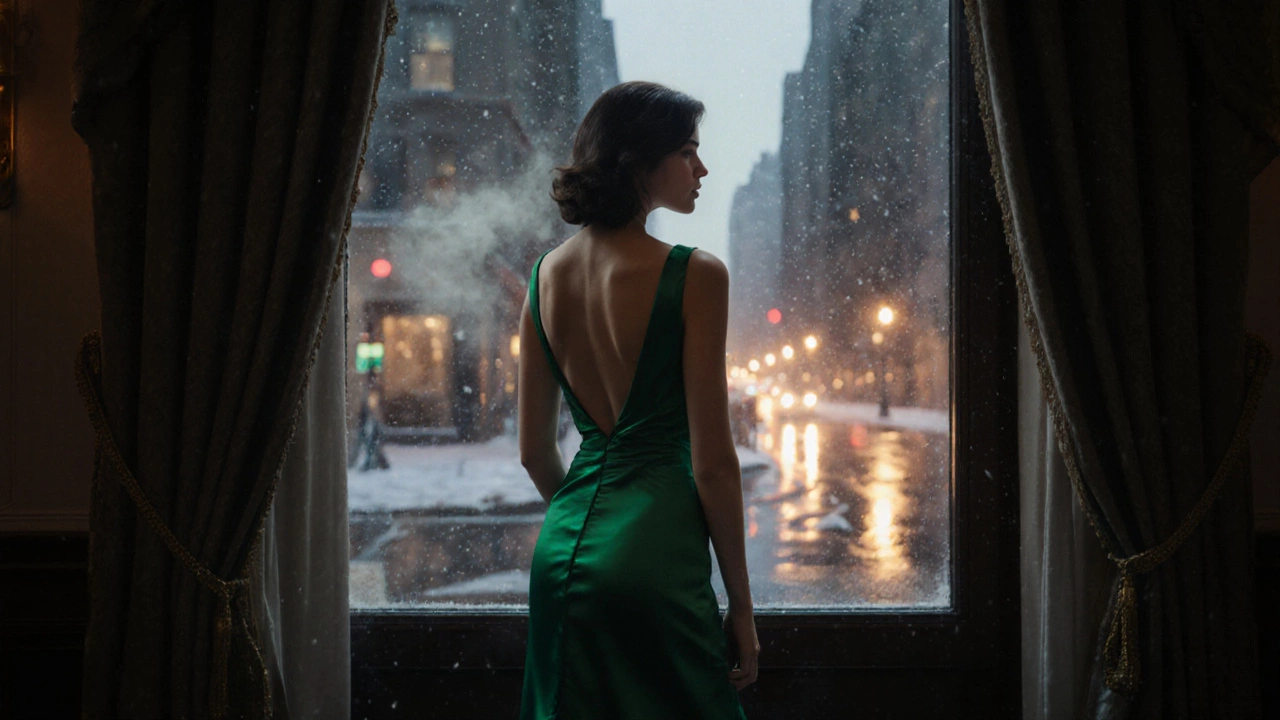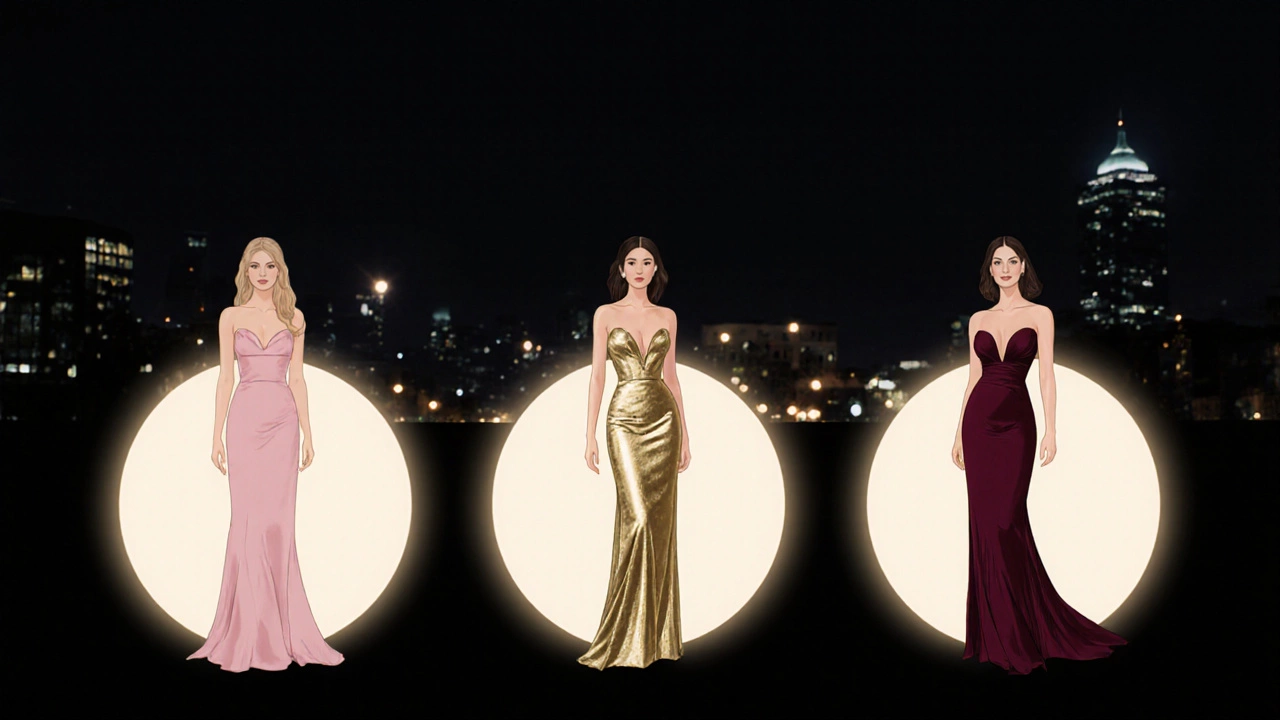What Is the Best Color for a Cocktail Dress? Expert Picks for 2025

- Cleo Fairchild
- 16 November 2025
- 0 Comments
Cocktail Dress Color Selector
Choose your skin tone and event type to get personalized recommendations from the 2025 expert guide.
Choosing the right color for a cocktail dress isn’t about following trends-it’s about matching the moment, your skin tone, and the vibe of the event. Too many people pick a shade because it’s popular, only to feel washed out or out of place under the lights. The best color for a cocktail dress isn’t one size fits all. It’s personal. And it’s practical.
Black Is Still the Default-But Why?
Black is the go-to for a reason. It’s slimming, timeless, and works in every lighting condition-from dim candlelit dinners to bright club spots. A well-tailored black cocktail dress doesn’t scream for attention; it commands it. Designers like Chanel and Yves Saint Laurent built legacies on this one shade. In 2025, black isn’t boring-it’s strategic. If you’re attending a wedding, gala, or corporate holiday party, black is your silent confidence move.
But here’s the catch: not everyone looks good in black. If you have cool undertones in your skin, pair it with silver jewelry. Warm undertones? Go for gold. A black dress with no contrast can make you look flat. Add texture-lace, velvet, or a subtle metallic thread-to keep it from looking like a costume.
Red: Bold, But Only If You Own It
Red is the color of power. It’s what women wear when they want to be remembered. A crimson or berry-toned cocktail dress turns heads-not because it’s loud, but because it’s intentional. Think of it like a perfectly poured espresso: rich, deep, and impossible to ignore.
Real talk: red doesn’t flatter everyone. If your skin is fair with pink undertones, avoid orange-reds-they’ll make you look flushed. Instead, go for blue-based reds like cherry or burgundy. If you have olive or deeper skin, true red or wine shades will make your skin glow. This isn’t about being daring-it’s about balance. A red dress with minimal accessories lets the color speak for itself.
Pro tip: In 2025, designers are leaning into matte reds over glossy. Shiny reds can look cheap under artificial light. Matte finishes look expensive and modern.
Emerald Green: The New Neutral
Forget navy. In 2025, emerald green is the new black. It’s rich without being flashy, elegant without being stuffy. Think of it as the velvet jacket of the dress world-subtle luxury.
This shade works for almost every skin tone. Cool undertones? Go for jewel-toned emerald. Warm undertones? Try moss or forest green with golden undertones. It’s especially flattering for autumn and winter events. The color has a depth that changes slightly under different lights, giving you that ‘I didn’t try too hard’ effect-even when you did.
Brands like Emilia Wickstead and Erdem have made emerald a signature. It’s no longer just a seasonal pick. It’s a staple. And unlike pastels, it doesn’t fade into the background. It holds space.
Blush and Soft Pink: For the Quietly Confident
Soft pink isn’t for brides-only anymore. In 2025, blush and rose quartz tones are showing up at cocktail parties, gallery openings, and even business dinners. It’s the color of quiet strength-not the loud kind.
This shade flatters medium to deep skin tones beautifully, giving a warm, radiant glow. On fair skin, it adds a natural flush-like you just came in from a walk in the crisp air. Avoid baby pink; it reads as juvenile. Look for tones with a hint of mauve or peach to ground it.
Pair it with nude heels and minimal jewelry. A blush dress with a structured silhouette looks polished, not playful. It’s the perfect choice if you want to stand out without shouting.

Gold and Metallics: For When You Want to Shine
Gold isn’t just for Christmas parties anymore. A subtle metallic cocktail dress-think liquid gold or brushed bronze-works for New Year’s Eve, award nights, or even a high-end birthday dinner. The key is texture. A dress that catches the light just right looks expensive. One that sparkles like a disco ball? Not so much.
Real gold tones work best on warm skin tones. Cool undertones? Go for silver, platinum, or champagne. Avoid overly shiny sequins unless you’re heading to a Vegas show. In 2025, the trend is muted metallics: satin finishes, micro-glitter, or metallic embroidery that moves with you.
One mistake people make: pairing a gold dress with gold shoes and gold jewelry. It’s too much. Let the dress be the statement. Keep accessories simple-maybe just a single ring or a small clutch.
What Colors to Avoid (And Why)
Not every color is a cocktail dress winner. Here’s what to skip:
- Neon green or orange: These scream ‘costume’ not ‘cocktail.’ Save them for Halloween.
- White: Unless you’re the bride, white reads as disrespectful at most evening events. Even off-white can be risky.
- Light pastels (baby blue, mint): They wash out under indoor lighting and look like pajamas after 7 p.m.
- Dark brown: It can look muddy unless it’s a rich chocolate with a sheen. Most people mistake it for a mistake.
These aren’t hard rules-they’re context clues. A white dress might work at a beachside soirée in July, but not at a downtown gallery opening in November.
How to Choose Based on Your Skin Tone
Here’s a simple trick: hold up a piece of silver and gold jewelry next to your face in natural light. Which one makes your skin look brighter?
- Cool undertones (veins look blue, silver looks better): Try navy, emerald, plum, silver, icy pink.
- Warm undertones (veins look green, gold looks better): Go for olive, rust, gold, coral, deep red.
- Neutral undertones (both metals work): You’re lucky. Almost everything looks good. Stick to classic black, burgundy, or charcoal.
This isn’t science. It’s a shortcut. If you’re unsure, try on three colors in natural light. The one that makes your eyes pop and your skin glow? That’s your color.

Season and Setting Matter More Than You Think
November in Bristol? It’s damp, cool, and dim. You’re not at a beach party. A light lavender dress might look pretty in a photo, but under streetlights and rainy skies? It’ll look washed out. Darker, richer tones-black, burgundy, forest green-absorb light instead of fighting it.
Summer events? Lighter tones like blush or champagne work fine. But in winter, you want color that holds its own. Think of it like clothing layers: your dress should be the outermost layer, and it needs to stand up to the environment.
Also, consider the venue. A candlelit restaurant? Go dark. A rooftop bar with string lights? A metallic or jewel tone will sparkle. A corporate holiday party? Stick to classic black or navy. The setting tells you what’s appropriate-not Instagram.
The Real Secret: Fit Over Color
Here’s the truth no one tells you: a perfectly fitted dress in a ‘wrong’ color looks better than a poorly fitted one in the ‘right’ color. A dress that hugs your waist, flares at the hips, and doesn’t bunch under the arms will always win. Color attracts attention. Fit earns respect.
If you have to choose between a slightly off-color dress that fits like a second skin, or a perfect shade that’s too tight in the bust? Go with the fit. You can accessorize a color. You can’t fix a bad cut.
And if you’re unsure? Rent it. Try three different colors. See how they look when you move, sit, laugh. Take photos in natural light. Don’t just rely on the dressing room mirror. That’s how you find your color-not by guessing, but by testing.
Final Rule: Wear What Makes You Feel Like You
There’s no universal ‘best’ color. There’s only what makes you feel powerful, comfortable, and like the version of yourself you want to show up as. That’s the real standard.
Some people look radiant in red. Others glow in black. A few find their match in emerald. It’s not about what’s trending. It’s about what works for your body, your skin, your mood, and the night ahead.
So skip the Pinterest boards. Skip the influencer’s pick. Try on the dress that makes you pause when you turn around. If you catch yourself smiling at your reflection-that’s the one.
Is black still the best color for a cocktail dress in 2025?
Yes, black remains the most versatile and reliable choice for cocktail dresses in 2025. It works for nearly every event, skin tone, and lighting condition. Designers continue to favor black because it’s slimming, timeless, and effortlessly elegant. However, it’s no longer the only option-rich tones like emerald, burgundy, and muted gold are now equally respected.
What color looks best on fair skin?
Fair skin looks best with colors that add warmth and contrast without washing you out. Jewel tones like deep plum, emerald green, and navy are ideal. Soft blush with a mauve undertone also works well. Avoid pastels like baby blue or mint-they can make fair skin look pale. If you’re unsure, test gold and silver jewelry: if silver looks better, go for cool-toned colors; if gold looks better, choose warm tones like rust or coral.
Can I wear white to a cocktail party?
Generally, no. White is traditionally reserved for brides, and wearing it to a cocktail party can come across as inappropriate or unintentionally rude. Even off-white or ivory can be risky unless the event is explicitly themed or held in a very casual setting, like a beachside summer soirée. Stick to darker, richer shades to avoid miscommunication.
What’s the most flattering color for dark skin tones?
Rich, saturated colors like emerald green, royal blue, deep burgundy, and true red are stunning on dark skin tones. These colors create beautiful contrast and enhance natural warmth. Metallics like gold and bronze also glow beautifully. Avoid muddy tones like dark brown or olive unless they’re very rich and have a sheen. The goal is to let your skin shine-not compete with it.
Should I match my jewelry to my dress color?
Not necessarily. Matching jewelry exactly to your dress can look forced or cheap. Instead, match your metal tone to your skin’s undertone: silver for cool tones, gold for warm. Let the dress be the star. A black dress? Try gold hoops. A red dress? A simple silver pendant. The goal is balance-not uniformity.


